The setting sun cloaked the evening sky in shades of pinky pastel, and lit up the island that dominates the coastline around here. A woman wandering by grabs a knife and in swift strokes, beheads for us the three struggling Kahawai on the beach.
“No taste like it,” she sighs in satisfaction. “From the sea to the plate in one hour!” Refusing to take even a single fish for her trouble however, she then strolls off into the sunset with her Bichon Frise toy dog dancing beside her.
More on this story later but let us start from the very beginning. The east coast beaches where we met this woman are one of the best-kept secrets of New Zealand tourism and an opportunity to experience the good old-fashioned manaakitanga (hospitality) of rural New Zealand. Here you find the beginnings of what grew into Ecotourism with a five star price tag. Back in the early days of ecotourism, local Kiwis wholeheartedly shared their skills, knowledge of fishing spots as well as unique insights with visitors and thought nothing of jumping in rivers with them, taking them shooting and otherwise sharing the assorted homemade thrills of New Zealand.
Named after the ancestor of the Ngati Awa tribe, Te Moana a Toi te Huatahi, (Sea of Toi) was promptly renamed Bay of Plenty for its jaw dropping beauty and abundant food resources by James Cook the British explorer. The Eastern Bay of Plenty is the gateway to the wilderness paradise that gave birth to ecotourism and along with honesty boxes and other quaint reminders of the past, there are still people who will pick you up and take you fishing with them.
Such is the way also in the tiny seaside village of Matata, just 28 kilometers from Whakatane, the gateway to the Eastern Bay. A lot of people whiz past the few shops and a pub; intent on reaching the nearby town and they miss the wetlands, the quirky Loch Ness in the recently reclaimed lagoon, the pristine stretch of beach, where all there is between you and Nature is the skin you inhabit.
A ring of islands circle the throat of the Eastern Bay. On a clear day you can see them all, from Motiti in the west to Whakaari, the island volcano perched 40 kilometers offshore to Motouhora Island (Whale Island), which is so close that some brave people have swim the eight kilometers expanse between the island and the picturesque town of Whakatane. 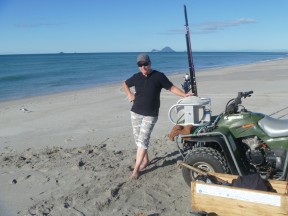
And now about the fishwife with the toy dog we began this story with. It all started when I was at home and my Karate Sensei rang me up. She had taught me up to the blue belt stage 20 years ago and is now a keen fishwife. “I’m just baiting the lines,” said she and added, “I will pick you up in 20 minutes.”
This is the village fishing call and “baiting the lines’ stands for the long line fishing technique. A fishing line is taken one or two kilometers out to sea and left to drift; hooks baited with juicy morsels dangling beneath the surface. After a brief waiting time, (30 minutes at the most, and just enough to have a glass of wine and bait the surf casting rods), the line is winched back in. Most people take the long line out with a kayak but Sensei Sue has a secret weapon, a battery operated torpedo! Even better, she has a four-wheel motorbike that is a fishwife’s dream car. So she and her partner Sharon picked me up and I scrambled aboard the bike, already packed with fishing gear. Down on the beach we met Greta (a recent convert into fishwifery) already armed with a rod and a yellow bucket. 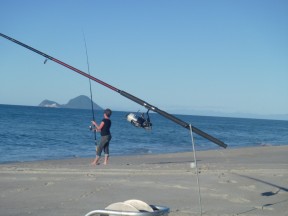
The line was then attached to the torpedo and released into the sea, dragging the baited fishing line behind it. Then it was time for a nice glass of wine as we watched the birds working the sea and congratulated ourselves for having yet another day in the paradise of the Bay of Plenty. _Winching the line in is effortless. A battery-operated winch does the work while we fishwives scan the sea, estimating the catch. The weight of the line indicated a haul but the first thing in was a bundle of kelp (a seaweed). Not a good sign. Then a splash was seen in the waves and the first of our haul of kahawai arrived, quickly followed by a snapper. Unhooking the fish from the line is the ballet of the modern fishwife. We danced along the line, deftly grabbing our catch and laying them reverently in the beach.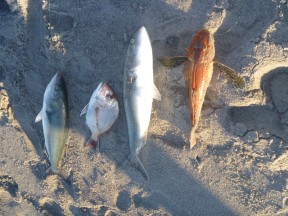
But Sensei Sue who has a black belt in Karate and endless years of fishwifery up her sleeve was unable to put the fish out of their landlocked misery. So we all stood around uselessly, unwilling to have fish smell on our clothes or blood on our hands. That’s when the woman with the dog arrived and swiftly dispatched our fish.
As the sun sinks into the cold breath of night, the fishwives of Matata roll up their fishing lines, hang the catch on the handlebars of the motorbike and head home to heat the pan.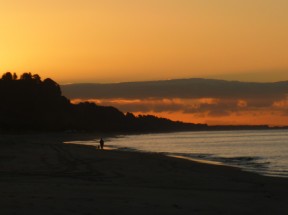
Dianne Sharma-Winter is a writer and a traveler roaming between India and New Zealand.






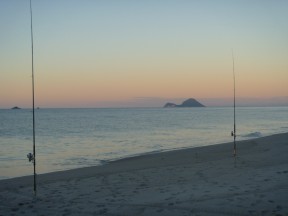

What a fantastic piece of writing this! It’s been so long since i read something so beautifully written. Thanks for sharing Dianne and Reema. I am going to blog about this and give a link to your wonderful article. Cheers!
thanks for dropping by Tina!
There you go Dianne – http://allthatittakes.wordpress.com/2011/04/21/unboxed-writers-»-a-fishwife’s-tale/
Love!
thoroughly enjoyable … and so typical, wanting neither the smell of fish on the clothes, nor the blood on the hands, but definitely wanting the fish in the pans … 🙂
Still girly after all these fishing expeditions! Pus of course the fish would LOOK at one!